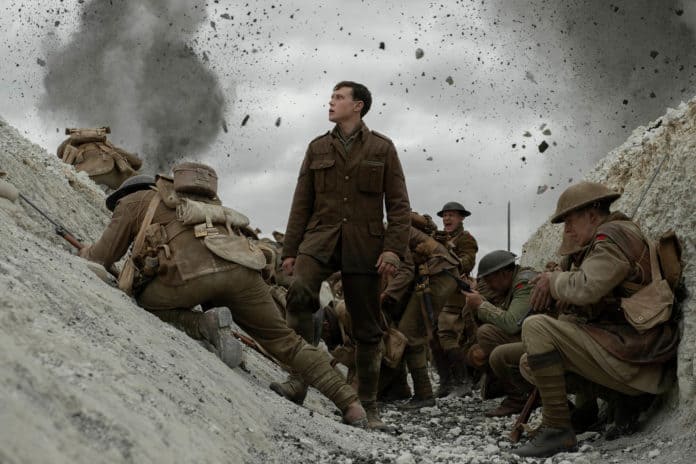Film review: 1917 / Director: Sam Mendes / Released: 2019
1917 is one of those rare films that appear every once in a while, to remind you what great cinema is all about. And not from a technical point of view only. I stress this because the focus has been on the directional brilliance of the film: Sam Mendes has shot the film using a single-shot effect, with the camera crew constantly following the protagonists in what seems like some incredible camera work. But it is really much more than a technical achievement; the technical details are there to help with the flow and rhythm of the feature and do not act as an extra protagonist per se. The single-shot effect rather hints at the very breath of life even when life ceases to be.
You could easily classify 1917 as a war film but what lies beneath it is a highly compact, philosophical essay on time, space and eternity. The film has an organic flow that stems from the Buddhist teachings, and the existence of the protagonists lies within the Saṃsāra and the endless cycle of birth and rebirth. The depictions of the Tibetan Wheel of Life are ever-present throughout the film, where we view things in both their living and non-living state: dead and living animals, cherry trees cut down and then displayed in full bloom. People in need of power, greedy and arrogant leaders, the Realm of Hell and, of course, the final door to Nirvana. To fail to acknowledge the philosophical depth that 1917 encompasses in just under two hours is to fail to appreciate the film as a piece of art and to treat it as pure enjoyment. But let me give you an example.
I searched for a few negative reviews just to see what on earth one could complain about: to those who say the film relies on its technical aspect or that the plot has all kinds of clichés and exaggerations (jumping from bridges, orphan babies, falling planes, etc.) I can only say it is clear that they have taken the plot too literally when all the artistic devices Mendes has come up with are to be taken allegorically. In fact, it is the director’s ability to use these cinematic devices to create art, instead of producing a pile of banalities, that makes the film so unique.
When hell is choreographed (in the village of Écoust-Saint-Mein) as a scene taken right out from Wagner’s Gotterdammerung, or a depiction of underground trenches as Dante’s inferno, you cannot but marvel at Sam Mendes’ artistic merit to subliminally include references to Schopenhauer and the Western Art in his technically brilliant feat of the moving camera.
As for the acting, both George MacKay and Dean-Charles Chapman deliver among the finest performances we have seen this year (the fact that they were not nominated for an Academy award is surprising since their acting skills in this feature outdo their Oscar contenders). This is not surprising: Sam Mendes has been a stage director and here it shows: the theatricality that is often expressed by a simple facial gesture or movement is way beyond the hysterics of your typical war movie.
His decision and ability to use all the most innovative methods for the shooting of what seems a single-shot feature, together with the choreographed theatricality of all the actors and extras involved, results to a genre that goes beyond the average war film, a mixture displaying the realistic settings of a stage play and the cunning illusion of cinematic time. To quote Parsifal, here “time becomes space” indeed.
Add to this some absolutely brilliant cinematography that, apart from depicting just beautiful shots actually contributes to the unfolding of the plot. And then there is the cunning score of Thomas Newman who makes clever use of a variety of styles to highlight the different phases of life’s journey: from the solo cello to the electronic sounds, and from the epic to the pastoral solemnity of soaring strings that could easily pass as a work of Ralph Vaughan Williams or Finzi.
I could go on and on and write about the technical and philosophical depth of 1917, but that would be like dictating the viewer and their expectations. So let me conclude that 1917 is indeed a real work of art and a technical marvel at the same time.
The High Arts Review Silver
Featured Image: 1947 official website







